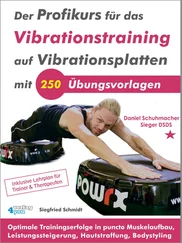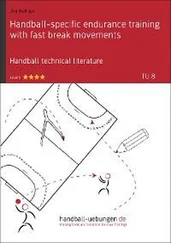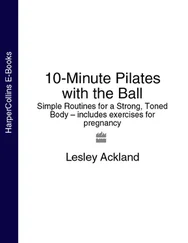•Signing the contraindication and safety instructions before the first plate training begins.
Sport plate & plate settings
Please refer to the manufacturer’s instructions as they can vary between machines. For amateurs I use sports plates with a total lift of about 4-8 mm (2x the amplitude, usually referred to as low or high. The exception was a previous plate with 12mm lift / 6 mm amplitude).
The latter is not suitable for beginners in my opinion, because it is too intense! For advanced users, this plate is quite suitable.
The most important thing in the quality of the plate is the number of vibrations (Hz number), set at the console, travels down continuously to the plate.
The amplitude set on the console, is slightly smaller on the vibrating plate.
The muscles need a clean contraction.
The fastest setting should be at a maximum of 33Hz in order to ensure a clean contraction (maximum speed strength).
We achieve the best results with a reduction in the number of Hertz, which should not be less than 25Hz.
Below this range (25Hz) should only be used by therapists with special machines with small amplitudes who work in the field of rehabilitation. The risk to internal organs, damage to the eyes or brain is difficult to assess from a personal trainer or private stakeholders. For your own protection omit frequencies below 25Hz.
Sport plate manufacturers who have gained around 10 years of experience have locked this frequency range, as sports plates can deliver in low amplitude 1.5G (gravitational acceleration) and up to 4G (depending on the Hertz frequency setting).
We have the best experience with Hertz settings between 25-33 Hertz.
The muscle is no longer able to guarantee a clean contraction at higher settings.
The tension of the muscle occurs through the plate with the contraction by the body in response to the message of the muscle spindle.
The counter-reaction of the body is called the tonic vibration reflex. This takes place approximately with the same strength as the plate acts upon us.
Since this process takes place very quickly in the subconscious, much higher tension conditions are achieved, as if for example you were lifting a weight. This is the biggest advantage over conventional strength training!
You must not underestimate the fact that you have without noticing it immediately to brace usually twice the body weight (in about 2G).
Train with high muscle tension!
The range around 34 Hertz is useful in the massage area to solve tissue adhesions, hematoma treatment, and improvement of blood circulation in tissue weakness and revitalization.
Simple principle: Waste products out, nutrients in!
A high blood flow to the smallest capillary is welcome!
Because the G-forces become stronger with the increasing number of Hertz, you should avoid vibrations over 50 Hertz.
The service life of your plates could be shorter if they are in commercial daily use.
Higher vibration levels can cause more noise, which can in turn lead to personal discomfort in the surroundings and automatically looses the relaxation effect.
In short, depending on the clientele, massages between 35-50 Hertz makes sense and helps to maintain a harmonious environment.
In our studios we do not move the plates; except in the time setting. The time setting is at 25 Hertz. Our plates have for years run without failures.
It is important for you to know that for a good massage it is not necessary to increase the frequency.
Familiarize the customer with the vibration plate
You can either lose or inspire potential customers on that first contact.
After the initial introductions and welcome, ensure that the contraindication are completely explained and that the customer signs the liability release.
Simultaneously get the customer’s data for your files and secure your company for personal injury / damage insurance details.
Calmly address the arguments of business compulsory insurance.
IMPORTANT:
 There should be no training without a signed contraindication.
There should be no training without a signed contraindication. 
Explain the benefits of the vibration plate and why you have decided to use this form of training to the customer.
 Mention the added value to the customer and explain to him why he should train here and not with a competitor!
Mention the added value to the customer and explain to him why he should train here and not with a competitor! 
Added Arguments:
•Muscle tension
•Strong blood circulation
•Unconscious training benefit
•Shorter training time
•Support from staff
•Training etc.
It is important to let customers that have not used a vibration plate before feel the effect.
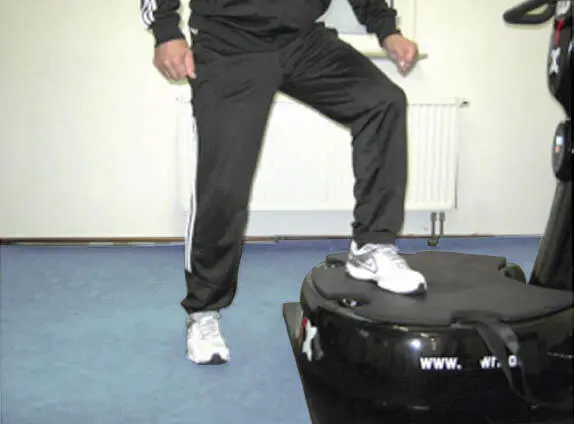
Ask the customer to place one leg onto the plate. Let them feel how the intensity of the vibration decreases when slightly lifting the heel from the plate, enabling them to gain the confidence and realise that they control the intensity.
While the customer has his foot on the plate, use the time to explain the safety procedures of the plate:
•Never put your head or the cervical spine directly on the plate.
•When doing standing exercises always slightly bend the knee joint.
•If you cannot see your toes than your knees are too far forward! Caution; cruciate ligament injuries is possible!You should keep the shin perpendicular as possible to the plate with the thigh tilting slightly backwards.
•Keep the elbows slightly bent while holding the arm rests- which protects the joints!
•Do not lay your chest on the plate (except with a thick protective mat, and only for one or two exercises).
•If the back is laid on the plate, always use a protective mat.
•In the supine position never place the shoulder blade, cervical spine or head directly on the plate.
•Do not go on the vibration plate if you have implants. Exceptions are dental implants, but then do not clench your teeth.
•Completely explain the emergency stop switch.
•Explain to new customers the Start-Stop operation.
•Only the trainer should adjust the amplitude and Hertz of the plate!
•To prevent meniscus injuries, please ensure that your feet are facing forward and parallel.
The following people should not undertake Vibration Training:
•Pregnant women.
•People with pacemakers.
•Patients with cancer or tumours.
•People with artificial joints, screw joints, or plates as a result of surgery.
•People with bone cement, for example to the spinal column.
•Children under 12 years.
•Patients after certain eye surgeries.
Here is a simple introduction exercise before we begin with the main training:
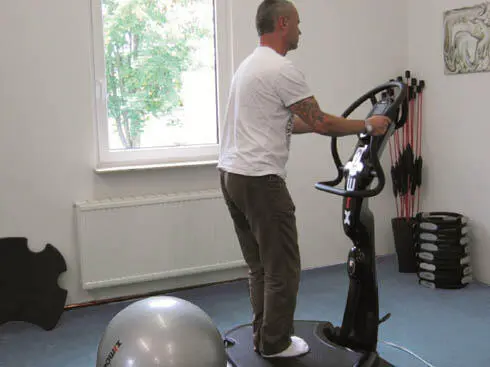
Читать дальше

 There should be no training without a signed contraindication.
There should be no training without a signed contraindication. 








